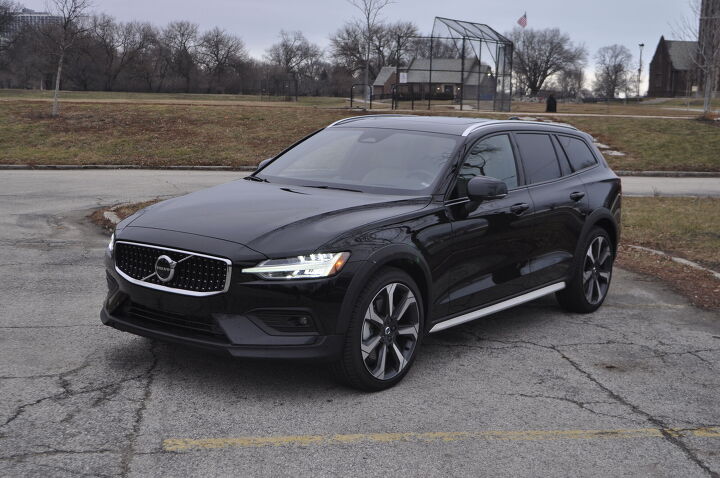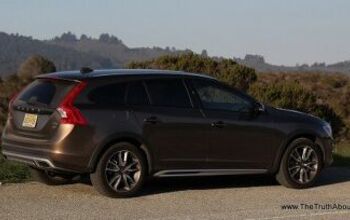2023 Volvo V60 Cross Country Review – Quiet Luxury

2023 Volvo V60 Cross Country Fast Facts
The word “quiet” in the headline applies in two different ways to the 2023 Volvo V60 Cross Country wagon. It means quiet in the literal sense – the cabin of this car isolates noise nicely, as befits a luxury car – but also in the more abstract sense. This is a car that seems to fly under the radar, even as it’s one of the last wagons left on the market.
That’s too bad, because it’s a comfortable commuter, though a bit lacking in the sort of sport that draws enthusiasts’ dollars.
The 2.0-liter turbocharged four-cylinder puts out 247 horsepower and 258 lb-ft of torque and has a mild-hybrid setup that includes regenerative braking. It’s a strong enough package that you’ll be fine in urban traffic, but this is a car meant to get you to grandma’s house instead of being hustled down the PCH, and that is quite apparent.
Similarly, the handling is just fine, maybe with just enough of a touch of sport to keep your playful side happy, and the ride is generally comfy though a bit stiff on occasion. Credit a double-wishbone suspension up front and an integral link setup in the rear.
This is a car meant for ferrying you and your passengers from point A to B in comfort, and it does that well. Wagons have often been stereotyped as boring – especially before the shift to minivans and later, SUVs, which made them seem cool again – but boring isn’t always bad. Sometimes it’s nice and peaceful.
The cabin helps. The materials are generally nice and price-point-appropriate. The vertical infotainment screen looks good, though the learning curve for its use is a bit steep, especially if you aren’t steeped in the Google ecosystem. The clean design can’t help but make me think of stereotypes about Swedish design and minimalism. Maybe the small Swedish flag tags on the seats subtly implanted that thought in my brain.
Volvo keeps the simple design going on the outside – it’s boxy and simple in style. Handsome in a plain way. The only splashes of spice are a rear spoiler and some silver trim, such as around the grille or on the bottom of the rear bumper.
Speaking of price points, this is not a cheap car. To that end, the standard features include a 12.3-inch digital gauge cluster, the 9-inch infotainment screen that essentially runs on Google apps, remote start, Bluetooth, satellite radio, uplevel audio, four USB-C ports, LED headlights, LED fog lamps, blind-spot alert with steering assist, rear cross-traffic alert with automatic braking, collision-avoidance assist, adaptive cruise control, lane-departure warning and lane-keep assist, and rear park assist.
Other standard features include a panoramic sunroof, leather seats, heated front seats, cooled front seats, keyless entry, four-zone climate control, and a 360-degree camera.
Opt for the Ultimate, the way my test car was optioned, and you get Harman Kardon audio, 19-inch wheels, and a head-up display. A Climate Package ($750) added headlamp cleaners, heated rear seats, and a heated steering wheel. Other options included a luggage cover ($345), the metallic paint ($695), and a power tailgate ($200). A 20-inch-wheel kit replaced the 19s and cost $3,200. Another $3,200 replaces the Harman Kardon audio with a Bowers and Wilkins system.
All that plus destination ballooned the car’s $54,100 base price to $63,585. Fuel economy is listed at 23 mpg city/30 mpg highway/26 mpg combined.
The driving dynamics here are mostly bland and commuter-friendly with a touch of sport. That’s OK. This car’s selling point is that it’s going to get you from place to place with little fuss and even less muss. It’s also meant to coddle you, and it does.
Cars like this can be hard to talk about. They don’t offer sexy, head-turning styling or the kind of performance that sends scribes like me diving deep into the dictionary looking for the appropriate superlatives. They offer luxury but not the kind of distinctive features that a ride with a six-figure sticker would.
What they do offer is solid utility for the moneyed person who is often carrying passengers and/or cargo about town. Oh, and comfort.
You won’t turn many heads, but you’ll get more than a few to nod at your sensible taste in automobiles
[Images © 2023 Tim Healey/TTAC.com]
Become a TTAC insider. Get the latest news, features, TTAC takes, and everything else that gets to the truth about cars first by subscribing to our newsletter.

Tim Healey grew up around the auto-parts business and has always had a love for cars — his parents joke his first word was “‘Vette”. Despite this, he wanted to pursue a career in sports writing but he ended up falling semi-accidentally into the automotive-journalism industry, first at Consumer Guide Automotive and later at Web2Carz.com. He also worked as an industry analyst at Mintel Group and freelanced for About.com, CarFax, Vehix.com, High Gear Media, Torque News, FutureCar.com, Cars.com, among others, and of course Vertical Scope sites such as AutoGuide.com, Off-Road.com, and HybridCars.com. He’s an urbanite and as such, doesn’t need a daily driver, but if he had one, it would be compact, sporty, and have a manual transmission.
More by Tim Healey
Latest Car Reviews
Read moreLatest Product Reviews
Read moreRecent Comments
- W Conrad I'm not afraid of them, but they aren't needed for everyone or everywhere. Long haul and highway driving sure, but in the city, nope.
- Jalop1991 In a manner similar to PHEV being the correct answer, I declare RPVs to be the correct answer here.We're doing it with certain aircraft; why not with cars on the ground, using hardware and tools like Telsa's "FSD" or GM's "SuperCruise" as the base?Take the local Uber driver out of the car, and put him in a professional centralized environment from where he drives me around. The system and the individual car can have awareness as well as gates, but he's responsible for the driving.Put the tech into my car, and let me buy it as needed. I need someone else to drive me home; hit the button and voila, I've hired a driver for the moment. I don't want to drive 11 hours to my vacation spot; hire the remote pilot for that. When I get there, I have my car and he's still at his normal location, piloting cars for other people.The system would allow for driver rest period, like what's required for truckers, so I might end up with multiple people driving me to the coast. I don't care. And they don't have to be physically with me, therefore they can be way cheaper.Charge taxi-type per-mile rates. For long drives, offer per-trip rates. Offer subscriptions, including miles/hours. Whatever.(And for grins, dress the remote pilots all as Johnnie.)Start this out with big rigs. Take the trucker away from the long haul driving, and let him be there for emergencies and the short haul parts of the trip.And in a manner similar to PHEVs being discredited, I fully expect to be razzed for this brilliant idea (not unlike how Alan Kay wasn't recognized until many many years later for his Dynabook vision).
- B-BodyBuick84 Not afraid of AV's as I highly doubt they will ever be %100 viable for our roads. Stop-and-go downtown city or rush hour highway traffic? I can see that, but otherwise there's simply too many variables. Bad weather conditions, faded road lines or markings, reflective surfaces with glare, etc. There's also the issue of cultural norms. About a decade ago there was actually an online test called 'The Morality Machine' one could do online where you were in control of an AV and choose what action to take when a crash was inevitable. I think something like 2.5 million people across the world participated? For example, do you hit and most likely kill the elderly couple strolling across the crosswalk or crash the vehicle into a cement barrier and almost certainly cause the death of the vehicle occupants? What if it's a parent and child? In N. America 98% of people choose to hit the elderly couple and save themselves while in Asia, the exact opposite happened where 98% choose to hit the parent and child. Why? Cultural differences. Asia puts a lot of emphasis on respecting their elderly while N. America has a culture of 'save/ protect the children'. Are these AV's going to respect that culture? Is a VW Jetta or Buick Envision AV going to have different programming depending on whether it's sold in Canada or Taiwan? how's that going to effect legislation and legal battles when a crash inevitibly does happen? These are the true barriers to mass AV adoption, and in the 10 years since that test came out, there has been zero answers or progress on this matter. So no, I'm not afraid of AV's simply because with the exception of a few specific situations, most avenues are going to prove to be a dead-end for automakers.
- Mike Bradley Autonomous cars were developed in Silicon Valley. For new products there, the standard business plan is to put a barely-functioning product on the market right away and wait for the early-adopter customers to find the flaws. That's exactly what's happened. Detroit's plan is pretty much the opposite, but Detroit isn't developing this product. That's why dealers, for instance, haven't been trained in the cars.
- Dartman https://apnews.com/article/artificial-intelligence-fighter-jets-air-force-6a1100c96a73ca9b7f41cbd6a2753fdaAutonomous/Ai is here now. The question is implementation and acceptance.








































Comments
Join the conversation
These are great looking wagons and like a few of you, I'm in the long roof club. There is no way in Haiti this is worth 65k. Sorry Volvo, but you guys kinda screwed the pooch over the last few years with awful reliability problems and cool but laggy infotainment issues. Like most cars in 2023, this too is overpriced by about 20-30%. Combine that with the amount of time this will be in for warranty issues and it's not worth the trouble. Sucks saying that because I really do like these, but if I buy one in the next few years, it will need to have that 12 year 125k mile warranty to consider it.
Under 250 HP, only 26 MPG, for $60k?
yeah they’re gonna need to try a little harder.
it does look great though